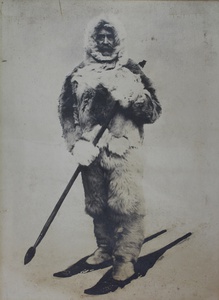| Method | Silver print |
| Artist | [Anonymous] |
| Published | National Geographic Society [n.d. c. 1909] |
| Dimensions | 612 x 446 mm |
| Notes |
A very scarce, large, full length portrait of the Arctic explorer Robert E. Peary wearing his parka and suit from the North Pole expedition of 1909 which consisted of furs modelled on those made by Inuits, snowshoes and a spear. "Photograph Courtesy National Geographic Society" in the lower right. Robert Edwin Peary (May 6, 1856 - February 20, 1920) was an American explorer and United States Naval officer most famous for his April 1909 expedition on which he claimed to be the first person to reach the geographic North Pole. Peary joined the United States Navy in 1881 and continued a naval career until he retired in 1911, taking leaves of absence for his Arctic explorations. Peary made his first Arctic expedition in 1886 when he attempted to cross Greenland with Christian Maigaard on dogsled but had to turn back when they ran out of food. The expedition was the then second farthest expedition into Greenland. Peary hired African American explorer Matthew Henson in 1887 as his assistant. Peary went on to do a second more ambitious trip in 1891-1892 to ascertain if Greenland was connected to a larger land mass in the North Pole taking seven others including his wife Josephine, Matthew Henson, and the explorer Frederick A. Cook. Peary was delayed when his leg was shattered after an out of control tiller on the boat he was on spun into his leg. After waiting for his leg to heal, he eventually set off in May 1892 returning in August 1892 having found evidence that Greenland was an island. Peary made his first attempt at reaching the North Pole in 1893-1894 by sledding through Greenland. As a result of his 1898-1902 expedition, Peary claimed to have made visual discovery of Jesup land, the northernmost tip of Greenland, before the Norwegian explorer Otto Sverdrup's expedition around the same time. Peary's claim was universally rejected. In 1905 Peary made his second attempt at reaching the North Pole in a ship called the Roosevelt but he had to stop due to adverse weather and ice conditions. His 1909 expedition was his last, purportedly reaching the North Pole on April 6, 1909. Upon his return home he found that his former colleague Frederick A. Cook claimed he had reached it first in April 1908 - a claim which was thoroughly discredited. While Peary's claim was widely accepted at the time, an analysis of Peary's expedition diary and other documents in 1988 cast doubt on whether he actually did reach the Pole. Peary is also known for studying and adopting Inuit survival techniques such as wear furs and building igloos. He also pioneered the technique of having support teams and supply caches whilst on his expeditions. Peary's legacy is complex, and his achievements have often overshadowed the problematic aspects of his life and career, particularly in relation to his treatment and exploitation of Inuit people. These included the sexual exploitation of Inuit women and girls by Peary and his crew, the theft and sale of a meteorite that was the only source of iron for the Inughuit group that acted as his hosts, and even the transportation of a group of six Inughuit people under false pretences as a favour to the American Museum of Natural History. Four of the group subsequently died to tuberculosis and were anatomised and displayed in the museum, along with other human remains collected by Peary and his crew during the expedition. In 1993, the remains of the four were repatriated. Condition: Laid to board, 35 mm tear in sheet on upper left, some surface dirt. Framed in a period frame. |
| Framing | framed |
| Price | £5,000.00 |
| Stock ID | 51224 |

